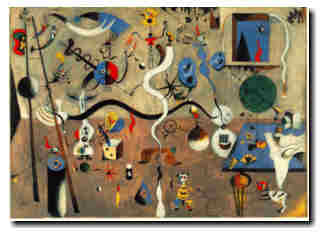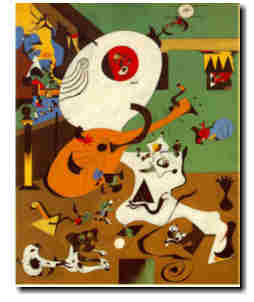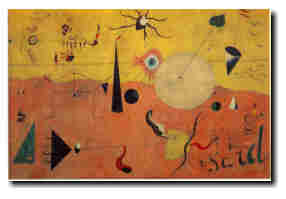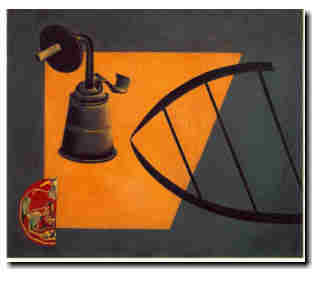


Miro studied in his native Barcelona, and the paintings in his first one-man show in 1918 reflected his interest in Catalan rural life. In 1919 he visited Paris and was for a while influenced by his friend Picasso's Cubism. However, when he settled in Pari's in the early 1920s, he shifted to the Surrealist group. Miros imagination was released by his exposure to the Surrealist idea of a creative unconscious, and for the rest of his life he strived to remain true to an intuitive or unconscious impulse. His fantasy led him to combine both abstract and figurative signs in paintings, sculptures, prints, and drawings throughout his career. Like other twentieth-century masters, Miro explored many media and worked on large commissions, including murals for Harvard University and two large ceramic walls for the UNESCO building in Paris.
MIRO'S THOUGHTS ON ART
"The spectacle of the sky overwhelms me. I'm overwhelmed when I see, in an immense sky, the crescent of the moon, or the sun. There are, in my pictures, tiny forms in huge empty spaces. Empty spaces, empty horizons, empty plains--everything which is bare has always greatly impressed me."
 "When
I began, the painters who made a strong impression on me were
Van Gogh, Cezanne, the Douanier Rousseau. When I loved the Douanier
Rousseau, I already loved popular art. The older I grow, the greater
importance this art has for me. A hay fork well carved by a peasant
is very important to me,"
"When
I began, the painters who made a strong impression on me were
Van Gogh, Cezanne, the Douanier Rousseau. When I loved the Douanier
Rousseau, I already loved popular art. The older I grow, the greater
importance this art has for me. A hay fork well carved by a peasant
is very important to me,"
"Immobility strikes me. This bottle, this glass, a big stone on a deserted beach-these are motionless things, but they set loose great movements in my mind. I don't feel this with a human being who changes place all the time in an idiotic way. People who go bathing on a beach and who move about touch me much less than the immobility of a pebble. (Motionless things become grand, much grander than moving things.) Immobility makes me think of great spaces in which movements take place which do not stop at a given moment, movements which have no end. It is, as Kant said, the immediate irruption of the infinite in the finite. A pebble which is a finite and motionless object suggests to me not only movements, but movements without end. This is translated, in my canvases, by forms resembling sparks flying out of the frame as out of a volcano."

"As there is no horizon line nor indication of depth, they
are displaced in depth. They are displaced also in plane, because
a color or a line leads fatally to a displacement of the angle
of vision. Inside the large forms, small forms move. What I am
seeking, in fact, is a motionless movement, something equivalent
to what is called the eloquence of silence, or what St. John of
the Cross meant by the words, I believe, of dumb music. I begin
my pictures under the effect of a shock which I feel and which
makes me escape from reality. The cause of this shock may be a
tiny thread sticking out of the canvas, a drop of water failing,
this print made by my finger on the shining surface of this table.
In any case, I need a point of departure, even if it's only a
speck of dust or a flash of light. This form begets a series of
things, one thing giving birth to another thing. And so a bit
of thread can set a world in motion. I start from something considered
dead and arrive at a world. And when I put a title to it, It becomes
even more alive.
In a picture, it should be possible to discover new things every
time you see it. But you can look at a picture for a week together
and never think of it again. You can also look at a picture for
a second and think of it all your life. For me, a picture should
be like sparks. It must dazzle like the beauty of a woman or a
poem. It must have radiance, it must be like those stones which
Pyrenean shepherds use to light their pipes."
 "I
feel the need of attaining the maximum of intensity with the minimum
of means. It is this which has led me to give my painting a character
of even greater bareness. My tendency towards bareness and simplification
has been practiced in three fields: modeling, colors, and the
figuration of the personages.
"I
feel the need of attaining the maximum of intensity with the minimum
of means. It is this which has led me to give my painting a character
of even greater bareness. My tendency towards bareness and simplification
has been practiced in three fields: modeling, colors, and the
figuration of the personages.
In 1935, in my pictures, space and forms were still modeled. There
was still chiaroscuro in my painting. But, little by little, all
that has gone. Roundabout 1940, modeling and chiaroscuro were
completely eliminated. A modeled form is less striking than one
which is not. Modeling prevents shock and limits movement to the
visual depth. Without modeling or chiaroscuro depth is limitless:
movement can stretch to infinity. Little by little, I've reached
the stage of using only a small number of forms and colors. It's
not the first time that painting has been done with every narrow
range of colors. The frescoes of the tenth century are painted
like this. For me, they are magnificent things. " [19581
INTRODUCTION WHAT ART IS SPIRIT OF ART REFLECTIONS BY ARTISTS MY WORKS OF ART